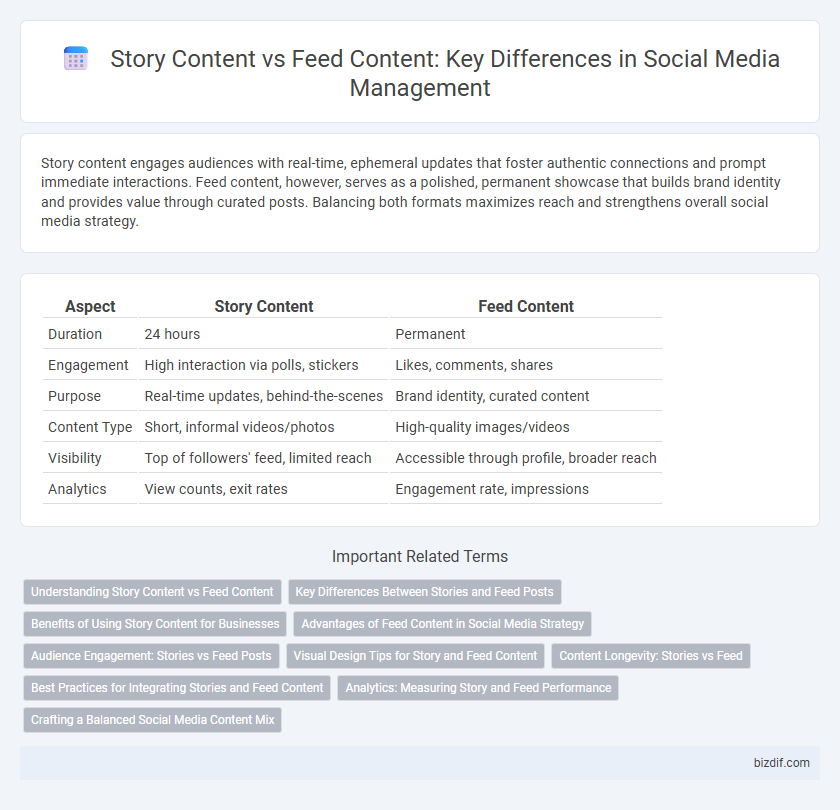Story content engages audiences with real-time, ephemeral updates that foster authentic connections and prompt immediate interactions. Feed content, however, serves as a polished, permanent showcase that builds brand identity and provides value through curated posts. Balancing both formats maximizes reach and strengthens overall social media strategy.
Table of Comparison
| Aspect | Story Content | Feed Content |
|---|---|---|
| Duration | 24 hours | Permanent |
| Engagement | High interaction via polls, stickers | Likes, comments, shares |
| Purpose | Real-time updates, behind-the-scenes | Brand identity, curated content |
| Content Type | Short, informal videos/photos | High-quality images/videos |
| Visibility | Top of followers' feed, limited reach | Accessible through profile, broader reach |
| Analytics | View counts, exit rates | Engagement rate, impressions |
Understanding Story Content vs Feed Content
Story content on social media offers ephemeral, engaging snapshots designed for real-time interaction and authentic connections, typically lasting 24 hours. Feed content provides a permanent, curated showcase that builds brand identity and attracts new followers through polished visuals and detailed captions. Brands optimizing both formats enhance audience engagement and maintain a dynamic online presence.
Key Differences Between Stories and Feed Posts
Story content on social media is ephemeral, designed for 24-hour visibility that encourages instant engagement and interactive features like polls, quizzes, and swipe-up links. Feed posts, however, provide permanent content that enhances brand identity with carefully curated visuals and captions to maximize long-term reach and discoverability. Stories prioritize real-time, authentic interactions while feed posts emphasize lasting impressions and sustained audience growth through algorithm-driven exposure.
Benefits of Using Story Content for Businesses
Story content on social media offers businesses increased engagement by leveraging ephemeral, interactive formats that create urgency and foster authenticity. It enhances brand visibility through features like polls, quizzes, and swipe-up links, driving direct audience interaction and measurable conversions. Utilizing story content also allows real-time updates and behind-the-scenes glimpses, strengthening customer relationships and boosting brand loyalty.
Advantages of Feed Content in Social Media Strategy
Feed content in social media enables consistent brand visibility by remaining accessible on profiles indefinitely, unlike fleeting stories. High-quality feed posts can be optimized with hashtags and keywords, enhancing discoverability and organic reach across social platforms. Feed content also supports engagement through comments and shares, contributing to long-term community building and audience retention.
Audience Engagement: Stories vs Feed Posts
Story content drives higher audience engagement through its ephemeral and interactive features, encouraging real-time responses and deeper connection with followers. Feed posts, offering permanence and curated visuals, build brand identity and sustained interaction through likes, comments, and shares over time. Balancing stories' immediacy with feed posts' longevity maximizes overall social media engagement and audience retention.
Visual Design Tips for Story and Feed Content
Prioritize high-contrast visuals and bold typography in story content to capture quick attention during short viewing times, while maintaining brand consistency through color schemes and fonts. For feed content, emphasize cohesive grid layouts and balanced image compositions to create an aesthetically pleasing profile that encourages longer engagement. Use a mix of dynamic movement for stories and polished, static images for feeds to optimize viewer retention and brand recall.
Content Longevity: Stories vs Feed
Feed content provides greater content longevity by remaining accessible on a profile indefinitely, allowing ongoing engagement and discovery over time. Story content, however, typically disappears after 24 hours unless saved as highlights, creating a sense of urgency but limiting long-term visibility. Brands aiming for sustained audience interaction benefit more from feed posts, while stories excel at real-time updates and ephemeral engagement.
Best Practices for Integrating Stories and Feed Content
Integrate stories and feed content by maintaining consistent branding elements such as colors, fonts, and tone to strengthen brand identity across platforms. Leverage stories for real-time engagement with polls, questions, and behind-the-scenes glimpses while using feed posts for polished, evergreen content that showcases products, testimonials, or key messages. Schedule stories and feed content strategically to create a cohesive narrative flow, driving higher audience interaction and reinforcing campaign goals.
Analytics: Measuring Story and Feed Performance
Story content performance is measured by metrics such as views, exits, replies, and swipe-ups, offering immediate insights into audience engagement and content effectiveness. Feed content analytics focus on likes, comments, shares, saves, and reach, providing a comprehensive view of long-term interaction and content resonance. Analyzing both story and feed data helps refine social media strategies by identifying high-performing content types and optimizing posting times for maximum impact.
Crafting a Balanced Social Media Content Mix
Story content drives real-time engagement with ephemeral, authentic glimpses, while feed content builds a curated, evergreen brand narrative that sustains long-term visibility. Balancing these formats enhances audience connection by combining immediacy and depth, ensuring consistent interaction and brand recall. Employing analytics to measure performance helps optimize the content mix, aligning with audience preferences and platform algorithms.
story content vs feed content Infographic

 bizdif.com
bizdif.com